
MDR-10RNCIP [US, FR, ES] 4-486-777-11(1)
English Noise Canceling Headphones
WARNING
The validity of the CE marking is restricted to only those
countries where it is legally enforced, mainly in the countries
EEA (European Economic Area).
The device complies with Part 15 of the FCC Rules.
Operation is subject to the following two conditions: (1)
this device may not cause harmful interference, and (2) this
device must accept any interference received, including
interference that may cause undesired operation.
Note
This equipment has been tested and found to comply
with the limits for a Class B digital device, pursuant to Part
15 of the FCC Rules. These limits are designed to provide
reasonable protection against harmful interference in a
residential installation. This equipment generates, uses
and can radiate radio frequency energy and, if not installed
and used in accordance with the instructions, may cause
harmful interference to radio communications. However,
there is no guarantee that interference will not occur in a
particular installation. If this equipment does cause harmful
interference to radio or television reception, which can be
determined by turning the equipment off and on, the user is
encouraged to try to correct the interference by one or more
of the following measures:
Reorient or relocate the receiving antenna.
Increase the separation between the equipment and
receiver.
Connect the equipment into an outlet on a circuit different
from that to which the receiver is connected.
Consult the dealer or an experienced radio/TV technician
for help.
You are cautioned that any changes or modifications not
expressly approved in this manual could void your authority
to operate this equipment.
–
–
–
–
Using the Center button
(Inline remote and
microphone cord for
iPod/iPhone/iPad)
Operation Explanation
Single press Plays/pauses a track of the
connected iPod.
Double press Skips to the next track.
Triple press Skips to the previous track.
Long press
Starts the “VoiceOver*” feature (if
available).
Press once when call is
incoming
Answers the call.
Press again Ends the call.
Hold down for about
two seconds and
release
Rejects an incoming call (two
low beeps confirm the call was
rejected).
* Availability of the “VoiceOver” feature depends on iPod
and its software version.
Note
Be careful not to unintentionally press any buttons when
you carry your iPod with the inline remote and microphone
cord connected.
Using the AI Noise
Canceling function
The AI Noise Canceling function analyzes environmental
ambient sound components and automatically selects the
most effective noise canceling mode.
When you press the AINC button while the POWER switch
is set to “ON,” beep sounds and the headphones start the
analysis. During the analysis (approx. 3 seconds), the POWER
indicator blinks, and the volume level is reduced from the
headphones.
When the analysis is completed, the most effective noise
canceling mode is selected and the volume level is revert to
the previous level.
Noise canceling mode types
NC Mode A: Noise mainly in an airplane is effectively
reduced.
NC Mode B: Noise mainly in a bus or a train is effectively
reduced.
NC Mode C: Noise mainly found in an office environment
(PC, copier, air ventilation, etc.) is effectively
reduced.
Tips
When the headphones are turned on, NC Mode A is set.
Press the AINC button again to reset the noise canceling
mode if ambient noise has changed, such as when you
move outdoors from a room.
Beep sound and
indicator status
Status/Function Beep sound POWER indicator
Power off No beep Lights off
Power on Beep once Lights on
AINC Beep twice Blinks twice
Low battery Long beep
(2 seconds)
Blinks quickly
(30 seconds)
Notes on use
What is noise canceling?
The noise canceling circuit actually senses outside noise
with built-in microphones and sends an equal-but-opposite
canceling signal to the headphones.
Notes on the noise canceling function
Adjust the earpads so that they cover your ears, otherwise
noise canceling will not function properly.
The noise canceling effect may vary depending on how
you wear the headphones.
Do not cover the microphone of the headphones with
your hands. The noise canceling function may not work
properly.
–
–
–
–
–
Microphone
After you turn on the power of the headphones, you may
hear a slight hiss. This is the operating sound of the noise
canceling function, not a malfunction.
The noise canceling function works for noise in the low
frequency band primarily. Although noise is reduced, it is
not canceled completely.
The noise canceling effect may not be pronounced in a
very quiet environment, or some noise may be heard.
When you use the headphones in a train or a car, noise
may occur depending on street conditions.
Howling may occur if you do not wear the headphones
correctly.
Howling may occur if you place an object such as finger
close to inside of the headphones. Keep it away from the
headphones.
Mobile phones may cause interference and noise. Should
this occur, locate the headphones further away from the
mobile phone.
Notes on using on the airplane
Do not use the headphones when use of electronic
equipment is prohibited or when use of personal
headphones for in-flight entertainment services is
prohibited.
Notes on handling
To disconnect the cord, pull it out by the plug, not the
cord. Otherwise the cord may break.
When connecting the cord, make sure to fully insert the
plug. If the plug is not fully inserted, no sound may result.
Because the headphones are designed to fit closely in your
ears, forcing them against your ears may result in eardrum
damage. Avoid using the headphones where they are
liable to be struck by people or other objects, such as a
ball, etc.
Pressing the headphones against your ears may produce a
diaphragm click sound. This is not a malfunction.
Clean the headphones with a soft dry cloth.
Do not leave the plug dirty otherwise the sound may be
distorted.
Be sure to consult a Sony dealer when the earpads
become dirty or damaged, or when the headphones
require repair work.
–
–
–
–
–
–
–
–
–
–
–
–
–
–
Do not leave the headphones in a location subject to
direct sunlight, heat or moisture.
Do not subject the headphones to excessive shock.
Handle the driver units carefully.
If you feel drowsy or sick while using this headphones,
stop use immediately.
Notes on headphones
High volume may affect your hearing. For traffic
safety, do not use while driving or cycling.
As headphones reduce outside sounds, they may cause a
traffic accident. Also, avoid listening with your headphones
in situations where hearing must not be impaired, for
example, a railroad crossing, a construction site, etc.
Note on static electricity
In particularly dry air conditions, noise or sound skipping
may occur, or mild tingling may be felt on your ears. This is a
result of static electricity accumulated in the body, and not a
malfunction of the headphones.
The effect can be minimized by wearing clothes made from
natural materials.
If you have any questions or problems concerning the
system that are not covered in this manual, please consult
the nearest Sony dealer.
Troubleshooting
No sound
Replace the battery with a new one.
You can use the headphones even without turning on the
power. In this case, the noise canceling function, Digital
Equalizer and S-Master are not active, and the headphones
operate as passive headphones.
Check the connection of the headphones and the
equipment.
Check that the connected equipment is turned on.
Turn up the volume of the connected equipment.
The noise canceling effect is not sufficient
The noise canceling function is effective in low frequency
ranges such as airplanes, trains, or offices (near air-
conditioning, etc.) and is not as effective for higher
frequencies, such as human voices.
Turn on the headphones.
Distorted sound
Turn down the volume of the connected equipment.
–
–
–
–
–
–
–
–
–
–
–
Power does not turn on or the headphones
do not operate properly
Check if the battery has expired (the POWER indicator
lights off) and the battery is inserted in the correct
orientation. Replace the battery with a new one or reinsert
the battery in the correct orientation.
No operation works
Set the POWER switch of the headphones to “OFF”,
confirm the connections, and then set the POWER switch
back to “ON”.
The connected iPod does not work
Check if the cord is connected correctly. Connect the L
type plug to the iPod and the other plug to the
headphones.
Features
Digital noise canceling headphones with Sony’s unique
DNC software Engine and Dual Noise Sensor Technology:
High precision canceling signal generated by digital signal
processing and microphones located both inside and
outside the housings enables outstanding noise canceling
performance.
Automatic AI (Artificial Intelligence) Noise Canceling
function
Automatic selection of the optimal noise canceling mode
based on intelligent analysis of environmental ambient
noise.
Digital Equalizer and full digital S-Master amplifier
Delivers ideal frequency response and high-quality music
reproduction with full digital processing.
Enfolding structure
Pressure-relieving cushions, tailored for the ears, provide a
wrap-around feel with acoustic sealing to deliver powerful
lows.
Lasting comfort
The lightweight and super soft cushions allow for
comfortable wearing over a long time.
Detachable cord
–
–
–
–
–
–
–
–
–
Specifications
General
Type Closed, dynamic
Driver units 40 mm, dome type (CCAW adopted)
Power handling capacity
100 mW
Impedance 50 Ω at 1 kHz (when the power is on)
24 Ω at 1 kHz (when the power is off)
Sensitivity 101 dB/mW (when the power is on)
100 dB/mW (when the power is off)
Frequency response
6 Hz – 24,000 Hz
Total Noise Suppression Ratio
1)
Approx. 22 dB
2)
Power source DC 1.5 V, 1 × LR03 (size AAA) battery
Mass Approx. 205 g (7.3 oz) including battery,
not including cord
Talk microphone Open circuit voltage level (Inline remote
and microphone cord for iPod/iPhone/iPad)
–42 dB (0 dB = 1 V/Pa)
Battery life
Battery
Approx. hours
3)
Sony alkaline battery
LR03 SIZE AAA
20 hours
4)
Note
The supplied battery was included in the package during
manufacturing (as a convenience to the user), it is possible
that the battery life may be depleted by the time of
purchase. The actual life of the supplied battery may be
shorter than the standard time described in this manual
when using a fresh battery.
When the battery is low
Replace the battery with a new one when the POWER
indicator blinks quickly or lights off.
Included items
Headphones (1)
Inline remote and microphone cord for iPod/iPhone/iPad
(1.2 m (47 1/4 in), four-conductor gold plated L-shaped
stereo mini plug) (1)
AAA battery (1)
Plug adaptor for in-flight use
5)
(1)
Carrying case (1)
Operating Instructions (1)
Warranty card (USA) (1)
Warranty card (Canada) (1)
1)
Under the Sony measurement standard.
2)
Equivalent to approx. 99.4% reduction of energy of sound
compared with not wearing headphones.
3)
At 1 kHz, 0.1 mW + 0.1 mW output
4)
Time stated above may vary, depending on the
temperature or conditions of use.
5)
May not be compatible with some in-flight entertainment
services.
Design and specifications are subject to change without
notice.
Compatible iPod/
iPhone/iPad models
You can use the headphones with only the following models
supporting remote control. Update your iPod, iPhone or
iPad to the latest software before use. In the Operating
Instructions, iPod, iPhone and iPad are collectively described
as “iPod” except in special cases.
iPhone 5
iPhone 4S
iPhone 4
iPhone 3GS
iPad (4th generation)
iPad mini
iPad (3rd generation)
iPad 2
iPod touch (5th generation)
iPod touch (4th generation)
iPod touch (3rd generation)
iPod touch (2nd generation)
iPod classic 120GB/160GB (2009)
iPod nano (7th generation)
iPod nano (6th generation)
iPod nano (5th generation)
iPod nano (4th generation)
iPod shuffle (4th generation)
iPod shuffle (3rd generation)
On copyright
iPad, iPhone, iPod, iPod classic, iPod nano, and iPod touch
are trademarks of Apple Inc., registered in the U.S. and other
countries.
“Made for iPod”, “Made for iPhone”, and “Made for iPad” mean
that an electronic accessory has been designed to connect
specifically to iPod, iPhone, or iPad, respectively, and has
been certified by the developer to meet Apple performance
standards. Apple is not responsible for the operation of this
device or its compliance with safety and regulatory standards.
–
–
–
–
–
–
–
–
–
–
–
–
–
–
–
–
–
–
–
Noise Canceling
Headphones
Operating Instructions
Mode d’emploi
Manual de instrucciones
US
FR
ES
MDR-10RNCiP
1
2
How to use/Mode d’utilisation/Modo de uso
Installing a battery/Installation d’une pile/Colocación de la pila
Connecting/Raccordement/Conexión
4
Wearing and controlling/Port et contrôles/
Colocación y control
After use
Turn off the power of the headphones.
Après utilisation
Éteignez le casque.
Después del uso
Apague los auriculares.
iPod/iPhone/iPad
iPod/iPhone/iPad
iPod/iPhone/iPad
indication
Indication
Indicación
indication
Indication
Indicación
Tactile dot (on the left)
Point tactile (à gauche)
Punto táctil (a la
izquierda)
3
Turning on the power/
Mise sous tension/Encendido
Using the AINC function/Utilisation de la fonction
RBAI/Uso de la función de inteligencia artificial de
supresión de ruido
Inline remote and microphone cord for iPod/iPhone/iPad
Cordon avec télécommande et micro intégrés pour iPod/iPhone/iPad
Cable con control remoto y micrófono integrados para iPod/iPhone/iPad
© 2013 Sony Corporation Printed in Malaysia
4-486-777-11(1)
Volume+
Volume+
Volumen+
Center button
Bouton central
Botón central
Volume–
Volume–
Volumen–
Microphone
Micro
Micrófono

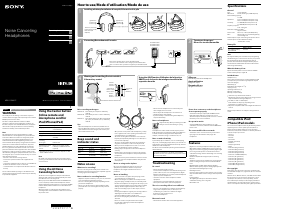


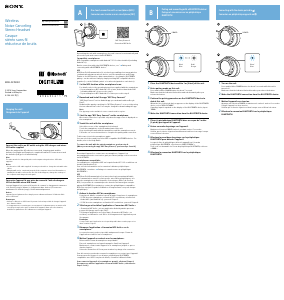
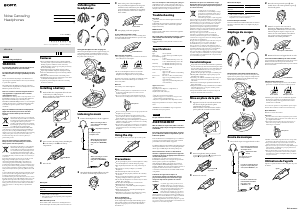
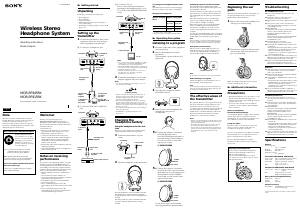
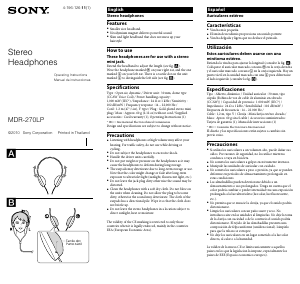
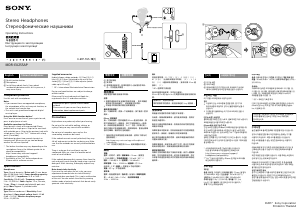
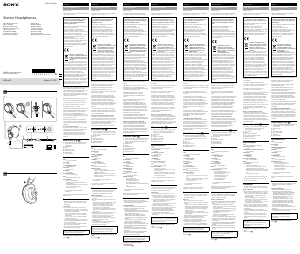
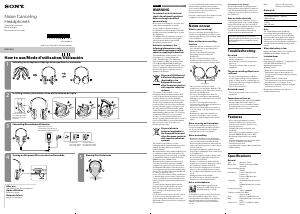
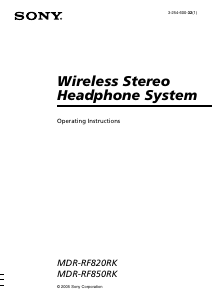
Join the conversation about this product
Here you can share what you think about the Sony MDR-10RNCiP Headphone. If you have a question, first carefully read the manual. Requesting a manual can be done by using our contact form.